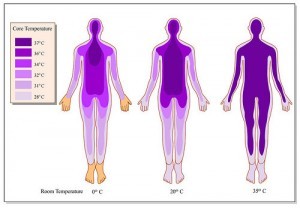 Body Temperature and Insulin Linked: Diabetes is becoming a very powerful disease. It has taken over the bodies of 23 million people in the U.S. and 171 million people globally. It is also expected to overtake the bodies of one million more people just by the end of this year. While many great advances have been made when it comes to diabetes, no cure has been found, though scientists and researchers are very hopeful that they will. However, there is always something new popping up in science and research that helps link one experiment to another and the next advance might be the link needed.
Body Temperature and Insulin Linked: Diabetes is becoming a very powerful disease. It has taken over the bodies of 23 million people in the U.S. and 171 million people globally. It is also expected to overtake the bodies of one million more people just by the end of this year. While many great advances have been made when it comes to diabetes, no cure has been found, though scientists and researchers are very hopeful that they will. However, there is always something new popping up in science and research that helps link one experiment to another and the next advance might be the link needed.
Diabetes mellitus is a disease that is caused by the lack insulin in one’s body. There are several types of diabetes such as Type 1 diabetes, Type 2 Diabetes and gestational (pregnancy) diabetes. Insulin comes from pancreas cells which can sometimes produce less secretion than the body needs, as a result, glucose levels are raised, which in turn causes different disorders like neuropathy, retinopathy, heart disease, stroke, kidney disease and erectile dysfunction over time. Diabetes can lead to amputation, coma and death if not treated correctly.
Insulin is important for the body to function correctly. It is a hormone that is important in regulating fat metabolism, carbohydrates and maintains normal blood sugar levels in the body. Insulin causes muscle, fat and liver tissue to take glucose from the blood and store it as a glycogen in the muscle and the liver. Without insulin, glucose cannot be taken by the body cells. Therefore, the body starts to use fat as its energy source, making individuals feel tired and their body begins to act differently.
In Japan, at the National Institute for Physiological Sciences, Professor Makoto Tominaga and Dr. Kunitoshi Uchida believe they have found a connection between core body temperature and insulin secretion. They believe that the TRPM2 ion channel in pancreatic beta-cells is a very important factor in the insulin secretion stimulated by glucose and gastrointestinal hormone that is secreted after food is consumed.
Insulin has been researched since it was first discovered in the 1920’s. In 2009, insulin was found to be linked with temperature regulation by a team led scientists at The Scripps Research Institute. Scientists were able to inject mice with insulin and watch as their core body temperature rose, their metabolism increase and fatty tissue released heat. The more insulin that was injected, the higher the metabolism increased.
Within the body, the TRPM2, also known as Transient Receptor Potential Cation Channel, is a temperature-sensitive Ca2+- permeable channel, a protein found in humans that can be found in pancreatic beta-cells. When this theory was tested on mice, both the professor and doctor found that the TRPM2-deficient mice were showing higher levels of glucose levels with reduced insulin secretion over that of uninhabited mice. TRPM2-defienct pancreatic beta-cells also showed smaller intracellular Ca2+ increase and a reduction of insulin secretion motivated by glucose and incretin.
Professor Makoto Tominaga and Dr. Kunitoshi Uchida reported that, “TRPM2 may control insulin secretion levels mainly by modulating intracellular Ca2+ concentrations. Finding the substance which stimulates TRPM2 effectively could lead to the development of a new therapy for diabetes mellitus.”
They believe that if the body temperature can be controlled, than perhaps the insulin can as well, which will produce a cure for diabetes and help many people in the world.